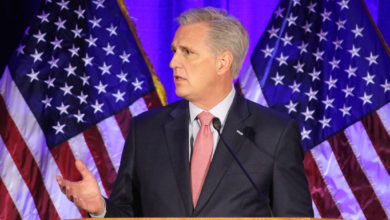 Anti-war protestors around the country demand “Money for jobs and education, not for war and occupation.” Photo: Bill Hackwell |
The budget, first announced on Feb. 7, 2005, proposes an increase in military and defense spending and a decrease in all “non-defense” spending that isn’t mandated by law—so-called discretionary spending. This includes nearly all domestic federally funded social programs. It would severely reduce or completely eliminate 150 much-needed federal programs. If the cuts go through, it will save the government around $15 to $20 billion in the next year. The national debt is close to $8 trillion.
This isn’t much money when one considers how much is lost by Bush’s tax cuts for the rich. In total, 257,000 U.S. millionaires will save $32 billion from Bush’s tax cuts. That’s $123,592 per millionaire.
So why doesn’t the government do away with the tax cuts? The answer goes to the heart of the system it serves—capitalism. The tax cuts help the rich and the budget cuts only hurt workers and the poor.
So the amount of money transferred by tax cuts to 257,000 millionaires is more than that saved by eliminating programs that tens of millions depend on for healthcare, housing, food, education and more. The Bush mantra is a capitalist’s dream: Give back to the rich and take-away from the poor.
A war budget
The most substantial portion of the budget by far is military spending.
The Pentagon budget is proposed at $419 billion, up roughly 5 percent from last year’s request. But this is not the totality of military spending. Funding for the occupations of Iraq, Afghanistan and any future wars fall outside the “official” budget. It will be accomplished through supplementals, beginning with the recent $81 billion “emergency” fund request for Iraq. Congress will likely give more as it is requested.
Military spending is also hidden in other areas of the budget. For example, funding for nuclear weapons development is part of the Energy Department’s allotment. The real U.S. military budget is at least $700 billion.
Eliminating social programs will have a devastating effect on the people who depend on them. But the $20 billion saved by the social program cuts is small change in the pockets of the millionaires and billionaires—the bankers, defense contractors, corporate officers and oil barons—who will benefit from Bush’s inflated military spending. The cuts equal less than one-fourth of the $81 billion proposed to continue the occupation of Iraq. And the cuts are only four percent of the official Pentagon budget.
The 2006 budget proposal illustrates the organic connection between the war at home and the war abroad. The occupation of Iraq is a class war against the Iraqi people. It is also a class war against workers in the U.S.
The human impact
The class component of the budget is readily apparent upon examining where the cuts will be made. Education, health care, housing, food stamps and other programs all risk massive cuts in funding.
One-third of the cuts are from education programs. Forty-eight education programs will be eliminated in total. Funding for education is being oriented toward programs that focus on improving student test scores. Meanwhile programs designed to serve students from low-income families are being cut.
Programs on the chopping block include Gear Up, Upward Bound and Talent Search. All of these prepare lower-income students for college. Even Start, a literacy program for low-income families that also helps to provide childcare to adult education students, is at risk.
School districts will see a cut in federal money that helps pay for the day-to-day operations of schools.
The Bush administration is touting its announced increases in the Pell grant program, but these increases will come at a high price—through the elimination of the Perkins Loan program. This program provides low-interest loans for middle- and low-income families.
In addition, $57 million will be cut from the Food Stamp Program, potentially affecting 300,000 working and poor families.
Around $200 million will be cut from the Low-Income Home Energy Assistance Program. This program serves five million mostly low-income families with elderly and disabled members. The cuts are especially difficult in light of ever-rising energy costs.
Environmental programs will also suffer. $100 million will be cut from grants for land and water conservation.
The U.S. Department of Housing and Urban Development’s Section 8 low-income voucher program will be cut, along with a realignment of the block-grant program. The cuts could hamper or halt low-income housing maintenance, inspection, and repair projects.
Money paid to provide veterans medical care will be cut.
State and local governments will lose an estimated $10.7 billion in grants, which will impact countless state and local programs that they fund.
Health care is in jeopardy. Bush hopes to cut $60 billion from Medicaid spending over the next decade. The cuts will affect the Medicaid program directly responsible for providing health care to 55 percent of adults and 90 percent of children living with HIV and AIDS.
In Bush’s recent State of the Union speech, he mentioned funding for programs serving people living with HIV and AIDS, including the Ryan White Care Act, a law that helps pay the health care bills for people living with HIV/AIDS. But instead of granting the requested $10 million budget increases, the 2006 budget actually flat-lines the program.
The proposed budget also cuts $4 million from the Center for Disease Control for HIV/AIDS research, cuts by $14 million the budget of the Housing Opportunities for Persons With AIDS project and gives nothing to the Minority AIDS initiative.
 At $257 million apiece, each “Raptor” fighter jet costs more than Even Start, a program for adult literacy on Bush’s chopping block. Photo: Colette M. Horton |
From 1929-1933, U.S. capitalism experienced its worst crisis ever—the Great Depression. Mass unemployment and poverty swept the country. By 1933, unemployment reached 25 percent of the U.S. workforce—approximately 15 million workers out of work—and it remained at 15 to 20 percent throughout the decade.
Some communities experienced even higher unemployment. In Cleveland, Ohio, unemployment reached 50 percent in 1932. Black workers in New York City experienced 50 percent unemployment throughout the decade.
In response to desperate economic conditions, U.S. workers fought back. In 1932, over 300,000 workers struck for union recognition or wage increases. By 1933, the number had tripled to 900,000. By 1934, that number had soared to 1.5 million, including heroic general strikes in Toledo, San Francisco and Minneapolis. Fierce labor struggles continued throughout the 1930s.
While the capitalist world suffered catastrophic economic decline, the Soviet economy grew without interruption throughout the 1930s, thus making communism an attractive alternative to failing capitalism in the eyes of millions of workers around the world—including the United States.
The Soviet economy had not experienced the ravages of contraction and mass unemployment in the 1930s. The Soviet economy was operated according to the principles of economic planning based on public need rather than private profit. Sectors of the capitalist class in the West wanted to demonstrate that capitalism too could provide a social insurance program ameliorating the effects of poverty and unemployment caused by capitalism’s cyclical crises.
In this world context, the administration of President Franklin Delano Roosevelt and the U.S. ruling class made concessions. These concessions, included programs created as part of the New Deal, like the Social Security Act of 1935 and the Minimum Wage Act of 1938. The New Deal programs became the framework for Medicare, Medicaid, unemployment insurance and many other social programs. In 1935, the Wagner Act gave workers the legal protection to organize unions.
Though criticized by much of the ruling class at the time, these reforms were enacted to calm the rising tide of working-class struggle before a revolutionary situation developed in the U.S. Time Magazine recognized FDR’s contribution to the maintenance of the capitalist system in 2000: “FDR’s signal domestic achievement was to rescue capitalism from the capitalists.”
Rolling back social gains
The social gains won through workers’ struggle in the 1930s and beyond are now in grave danger.
But the massive rollback did not begin with the current Bush administration. It started in the late 1970s when the U.S. ruling elite was recovering from its defeat in Vietnam. And it continued full force throughout the 1980s under Ronald Reagan and George H.W. Bush, and then through the 1990s under Clinton. Clinton’s welfare reform bill in 1996 threw tens of thousands of low-income people off welfare rolls, taking away needed federal assistance.
Social security, unemployment insurance, and other social programs were secured in the 1930s because of two main factors. On the one hand, the capitalists feared the rising tide of workers’ struggle in the U.S. On the other, the Soviet Union offered an attractive alternative to world capitalism, which was in a state of depression and paralysis.
The overthrow of the Soviet Union in 1991 eliminated the need for the Western capitalists to prove that they could guarantee a social safety net for those who are jobless—either because they had been laid off, or because they had reached retirement age.
Now, the Bush administration hopes to accelerate and complete this rollback. In the absence of a strong U.S. working-class movement and the socialist bloc, the U.S. rulers seek to take away the workers’ gains. This full-scale assault on the working class and poor, far from being an anomaly of an ultra-right administration, is really a return to the normal state of capitalism.
The rollback is really a global trend in advanced capitalist countries, not only in the U.S. but in European nations as well. These countries are using U.S. bosses’ aggressive attacks on workers’ rights as their model.
In Germany, workers facing the highest level of unemployment since World War II also face reduced jobless benefits. Those who have jobs work longer hours, with vacation and overtime pay cuts.
French workers are fighting to maintain the 35-hour workweek, a victory won over years of struggle. They also oppose reactionary welfare and labor law reforms. Unions and students staged massive demonstrations throughout the country in early March.
Ruling classes in all capitalist countries consider any minor infringement on their profits or limitation on capital expansion to be a crime. In the U.S., the ruling class currently sees an opportunity to overthrow any government that seeks independence, to crush any liberation movement that is growing in strength and to eliminate the entirety of social programs and services that exist for workers.
Continuing struggle
The Bush administration’s announcement of its fiscal year 2006 budget brought an immediate response, from grassroots activists to city officials, across the country. Even the Democrats expressed shock and outrage at expanding military spending and cutting social programs.
But the Democrats are incapable of fighting back in any meaningful way. They are part of the capitalist system of profit and greed. At best, the Democrats only propose reform. While it is vital to organize and struggle for reform, as long as the capitalist class is in power, both Democrats and Republicans will roll back reforms whenever they can. A movement against the proposed cuts must be independent of the capitalist parties and rooted in people’s struggle.
History has shown that as living conditions deteriorate—as unemployment and layoffs rise, as access to health care and housing becomes more difficult, as poverty increases—more and more people begin to struggle against those intolerable conditions. These conditions form the basis for a mass movement with the power to turn back the Bush administration’s attacks at home and abroad.






